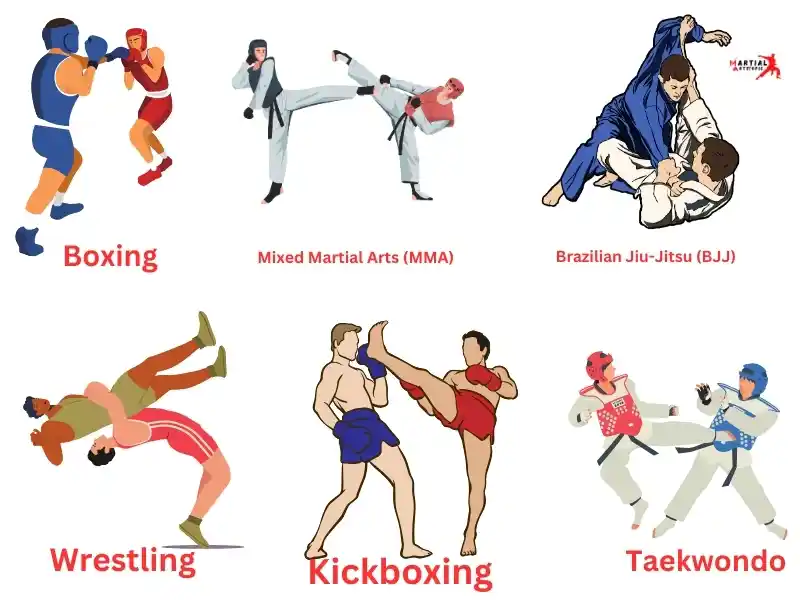
Combat Sports List
- Boxing
- Mixed Martial Arts (MMA)
- Brazilian Jiu-Jitsu (BJJ)
- Muay Thai
- Wrestling
- Judo
- Kickboxing
- Taekwondo
- Karate
- Sambo
Types of Combat Sports
Combat sports encompass a wide range of disciplines that emphasize physical contact and strategic maneuvering. From the powerful strikes of boxing to the intricate grappling techniques of Brazilian Jiu-Jitsu, combat sports offer diverse opportunities for athletes to test their skills and endurance. Whether you’re drawn to the agility of kickboxing or the discipline of judo, there is a combat sport suited to every individual’s strengths and interests. The variety within combat sports ensures that practitioners can find a style that resonates with them, making it an inclusive and dynamic realm for physical activity and personal growth.
1. Boxing

Boxing, also known as the “Sweet Science,” is a popular combat sport that requires both physical and mental discipline. It involves two opponents using their fists to throw punches at each other within a roped-off square ring. This ancient martial art has developed into a modern sport with strict rules and regulations to ensure the safety of the competitors. The techniques of boxing focus on footwork, agility, speed, and precision striking. It is not only a physically demanding sport but also requires strategic thinking and split-second decision-making. As one of the most celebrated combat sports, boxing has gained global recognition for its electrifying matches and legendary athletes. If you’re looking for an intense full-body workout that hones both your physical prowess and mental acuity, boxing might be just the sport for you!
2. Mixed Martial Arts (MMA)
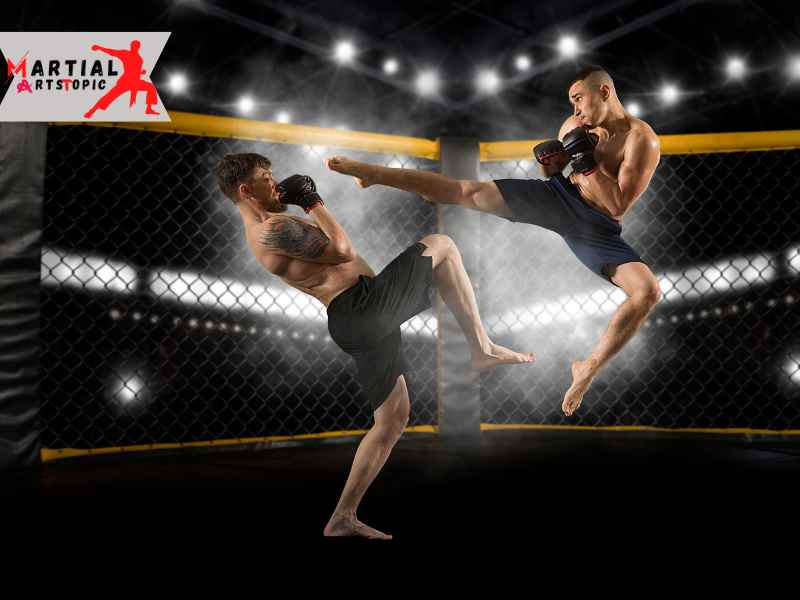
Mixed Martial Arts (MMA), also known as combat sports, is a dynamic and versatile discipline that combines various fighting techniques from different martial arts. With its roots in ancient traditions and modern competitive sports, MMA offers a thrilling and challenging experience for practitioners of all levels. From striking techniques such as punches, kicks, and elbows to grappling and ground fighting, MMA encompasses a wide range of skills that require dedication and focus to master. Whether you’re interested in self-defense, physical fitness, or competitive combat sports, MMA provides an exciting avenue for personal growth and development.
3. Brazilian Jiu-Jitsu (BJJ)
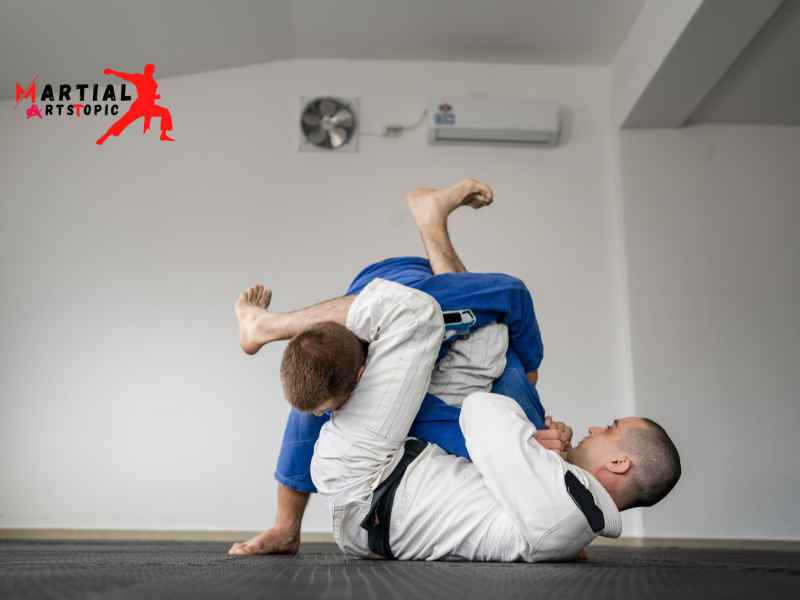
Brazilian Jiu-Jitsu (BJJ) is a highly effective martial art that falls under the category of combat sports. Originating from Brazil, BJJ focuses on ground fighting and grappling techniques, making it an essential skill for self-defense and competitive sports. This discipline emphasizes leverage and proper technique to overcome larger opponents, making it suitable for individuals of all ages and body types. Whether you’re looking to improve your physical fitness, learn self-defense, or compete in tournaments, Brazilian Jiu-Jitsu offers a comprehensive approach to combat sports training.
4. Muay Thai
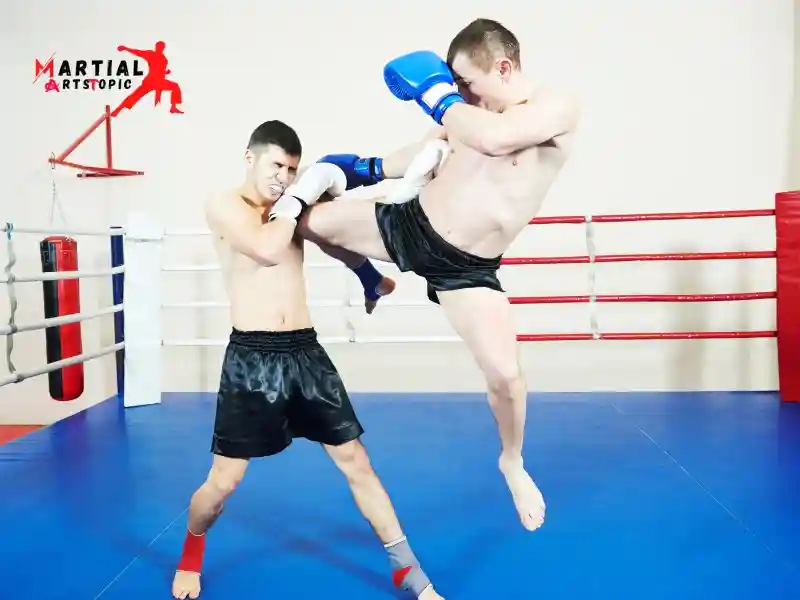
Muay Thai, also known as the “Art of Eight Limbs,” is a traditional combat sport that originated in Thailand. It is a form of martial arts that utilizes punches, kicks, elbows, and knee strikes, making it a highly effective and versatile fighting style. Muay Thai is not only a substantial form of self-defense but also an excellent way to improve physical fitness and mental discipline. With its emphasis on powerful strikes and clinching techniques, Muay Thai has gained popularity worldwide as a challenging and dynamic combat sport. Whether you’re looking to enhance your fighting skills or simply stay in top shape, Muay Thai offers a rewarding and intense training experience for practitioners of all levels.
5. Wrestling
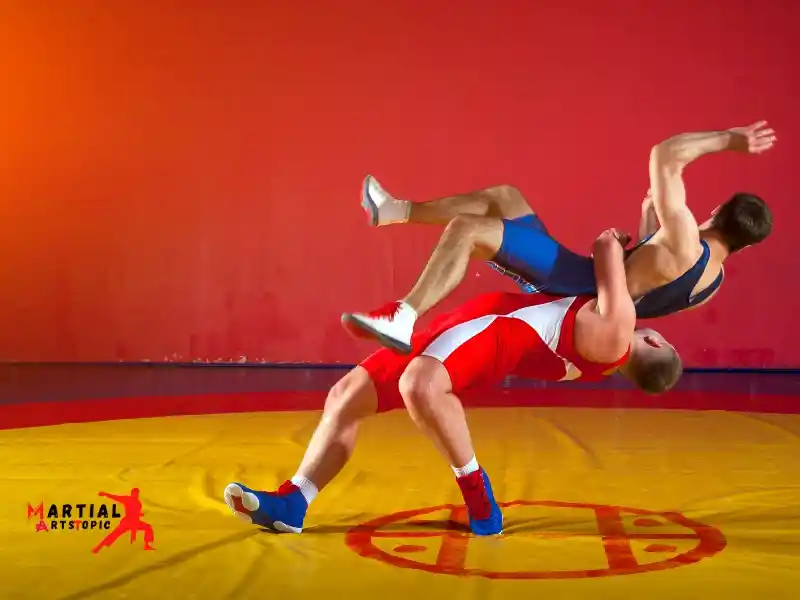
Wrestling is a dynamic and intense combat sport that has been practiced for centuries. It requires both physical strength and mental agility, making it a challenging yet rewarding discipline within the realm of combat sports. Wrestling involves grappling techniques, takedowns, and ground control, emphasizing the importance of leverage and technique over brute force. As one delves into the world of wrestling, they can expect to develop not only their physical prowess but also their strategic thinking and discipline. Whether you’re a seasoned athlete or someone looking to embark on a new fitness journey, wrestling offers a unique and invigorating experience within the realm of combat sports.
6. Judo
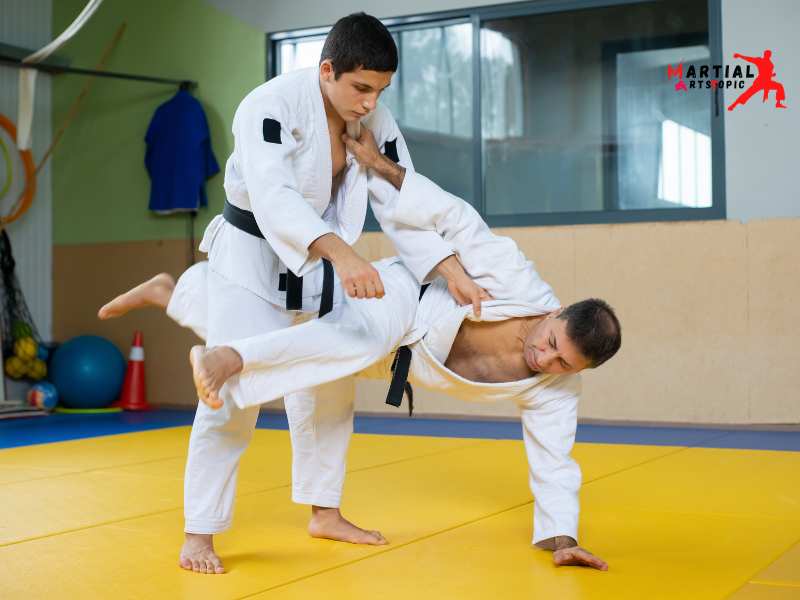
Judo, a popular martial art and combat sport, focuses on grappling and throwing techniques. Originating in Japan, Judo emphasizes using an opponent’s strength and momentum against them, making it an effective form of self-defense. Practitioners, known as judokas, train to develop agility, balance, and coordination while learning how to take down opponents with controlled force. Besides its practical applications in self-defense and combat sports, Judo also promotes mental discipline and physical fitness. For anyone interested in engaging in combat sports or honing their self-defense skills, Judo offers a comprehensive and rewarding training experience.
7. Kickboxing
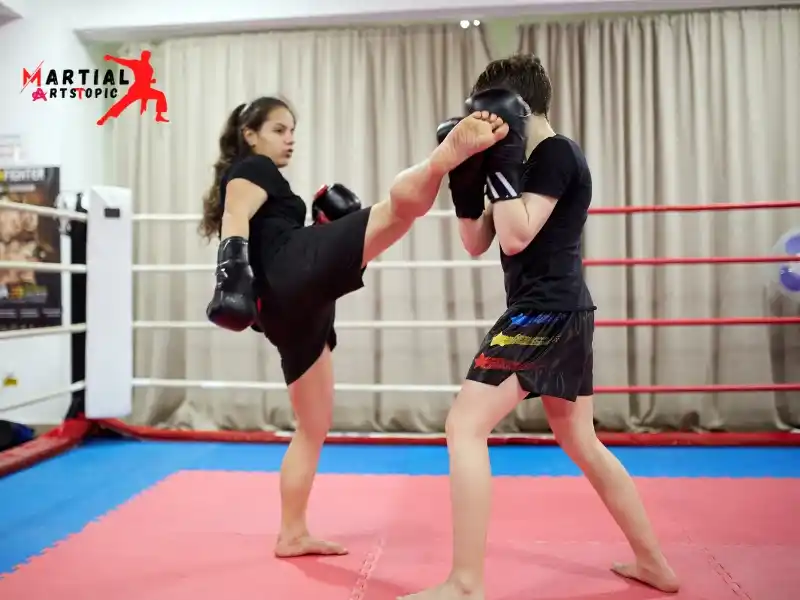
Kickboxing is a dynamic combat sport that combines elements of boxing and martial arts, including techniques such as punching, kicking, knee strikes, and elbow strikes. It provides a full-body workout while improving flexibility, strength, and cardiovascular endurance. Kickboxing is an excellent form of self-defense training and offers a high-intensity cardio workout. Whether you’re looking to improve your overall fitness or learn practical self-defense skills, kickboxing is a fantastic way to challenge yourself both physically and mentally. If you’re interested in combat sports, kickboxing is definitely worth considering for its physical and mental benefits.
8. Taekwondo
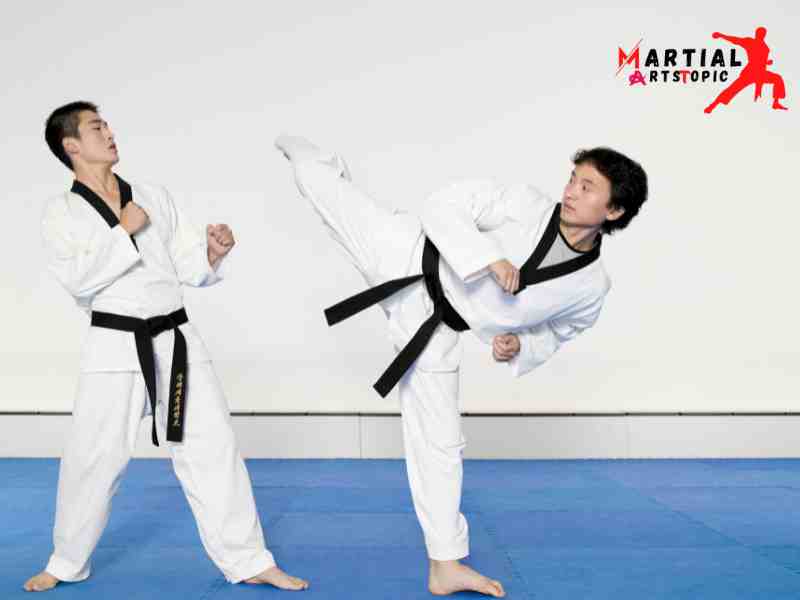
Taekwondo is a dynamic martial art that originated in Korea and has gained immense popularity as combat sports. It emphasizes kicking techniques, agility, and flexibility, making it an effective method of self-defense and a fantastic way to improve overall fitness. Taekwondo also focuses on mental discipline, making it a holistic approach to personal development. Whether you’re looking to enhance your physical abilities, boost your confidence, or simply engage in an exciting activity, Taekwondo offers a unique combination of athleticism and traditional values. So, if you’re ready to embark on a journey towards mastering this powerful martial art, Taekwondo might just be the perfect fit for you!
9. Karate
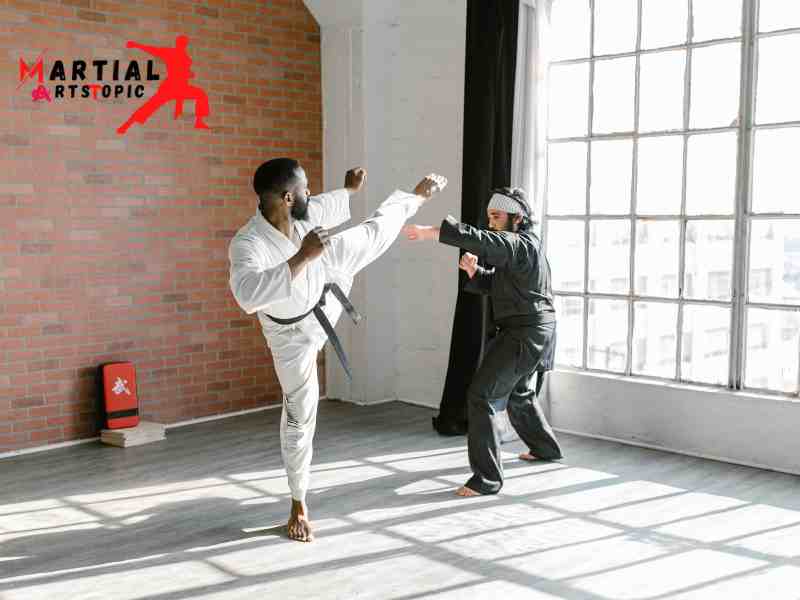
Karate, a traditional martial art originating from Okinawa, Japan, is a popular combat sport that emphasizes striking techniques such as kicks, punches, and knee strikes. It also incorporates open-hand techniques like knife-hands and spear-hands. Karate training not only focuses on physical conditioning but also instills discipline, respect, and mental fortitude. Practitioners of karate, known as karatekas, undergo rigorous training to develop agility, speed, and precision in their movements. The essence of karate lies in its emphasis on self-defense and the cultivation of inner strength. Whether you’re a beginner or an experienced martial artist, Karate offers a holistic approach to combat sports that can benefit individuals of all ages and fitness levels.
10. Sambo
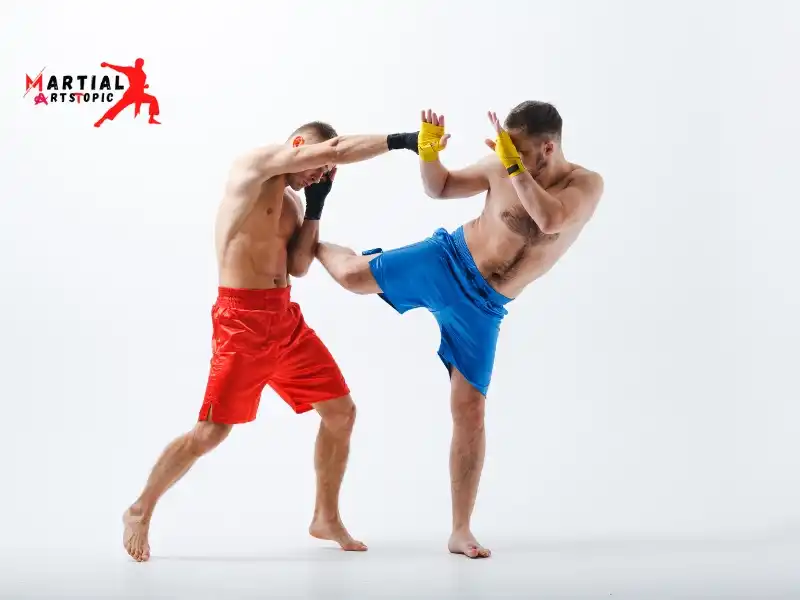
Sambo is a dynamic combat sport that originated in Russia, blending elements of judo, wrestling, and other martial arts. It emphasizes grappling, throws, and ground fighting techniques, making it a comprehensive martial art for self-defense and competition. Sambo practitioners develop strength, agility, and strategic thinking while honing their combat skills. As one of the most versatile combat sports, Sambo offers a unique blend of traditional and modern techniques that appeal to athletes and martial artists seeking a well-rounded approach to self-defense and physical fitness.
More Combat Sports
- Krav Maga: Krav Maga, developed in the 1930s by Imi Lichtenfeld, blends elements of boxing, wrestling, judo, and street fighting. This hybrid self-defense system has gained popularity worldwide for its practical techniques and is utilized by military and law enforcement agencies.
- Kung Fu: Kung Fu, originating in ancient China, encompasses various Chinese martial arts. Made famous globally through martial arts cinema and legendary figures like Bruce Lee and Jackie Chan, Kung Fu emphasizes self-defense techniques, meditation, and personal development.
- Sumo wrestling: Sumo wrestling, an ancient Japanese sport dating back to the 8th century, showcases massive athletes competing to push or throw each other out of a circular ring. Deeply rooted in Japan’s culture and Shinto practices, Sumo holds major tournaments throughout the year.
- Capoeira: Capoeira, originating in Brazil during the time of African slavery, combines fighting techniques with music, dance, and acrobatics. This unique martial art emphasizes fluid movements and offers a cultural experience through its incorporation of music and dance.
- Savate (French kickboxing): Savate (French kickboxing), developed in France in the 19th century, emphasizes kicks and punches. Fighters wear specialized footwear during competitions which sets it apart from other kickboxing disciplines.
- Hapkido: Hapkido is a Korean martial art that emerged in the 1940s focusing on joint locks, throws, and powerful strikes. With influences from Taekwondo, Judo, and Jujitsu; Hapkido is practiced primarily in Korea and regions influenced by Korean culture.
- Kyokushin Karate: Kyokushin Karate was founded in Japan in the 1960s emphasizing full-contact sparring and intense training. Known for its rigorous conditioning methods; it’s considered one of the toughest styles of Karate.
- Sanda (Sanshou): Sanda (Sanshou), a Chinese martial art developed by the Chinese military in the 20th century combines elements of Kung Fu with striking techniques such as throws and takedowns.
- Pankration: Pankration is an ancient Greek martial art that combines boxing and wrestling techniques. Although historically rooted; modern versions are showcased at events such as International Pankration Championship.
- Eskrima (Arnis): Eskrima (Arnis), originating in the Philippines as a weapons-based martial art focusing on sticks, knives, and improvised weapons; it is their national sport gaining popularity outside its home country as well.
- Lethwei: Lethwei, also known as Burmese bare-knuckle boxing, originated in Myanmar and dates back over a thousand years. This intense and ferocious combat sport allows a wide range of striking techniques, including headbutts. Key tournaments within this sport include the Myanmar Traditional Lethwei Championship and The Golden Belt Championship.
- San Shou: San Shou, also known as Chinese kickboxing or Sanda, is a modern Chinese martial art and combat sport that combines striking, kicking, throwing, and grappling techniques. Developed by the Chinese military, it is widely popular in China. The World Wushu Championships is the main event for San Shou practitioners.
- Taido: Taido is a martial art created in Japan in 1965 by Seiken Shukumine. It focuses on dynamic movements, evasion, and versatile striking techniques. Although not as popular as other martial arts, Taido holds competitions such as the Taido World Championships and the European Taido Championships.
- Wushu: Wushu is a modern Chinese martial art consisting of various traditional Kung Fu styles. Today, Wushu is a popular performance and competitive sport known for its dramatic forms and acrobatics. Major Wushu events include the World Wushu Championships and the Asian Wushu Championships.
- Wing Chun: Wing Chun originated in southern China in the 18th century. It is a close-range Kung Fu style emphasizing speed, efficiency, and practical self-defense techniques. Popularized by Bruce Lee, Wing Chun has spread globally and inspired the International Wing Chun Organization (IWCO) to oversee competitions and promote the art.
- Jeet Kune Do: Jeet Kune Do was developed by Bruce Lee in the 1960s as a hybrid martial art combining techniques from multiple disciplines like Kung Fu, boxing, and fencing. Known as the “Way of the Intercepting Fist,” Jeet Kune Do is more a philosophy than a rigid set of techniques supported by the Jeet Kune Do Federation (JKDF).
- Yaw-Yan or Dance of Death: Yaw-Yan or “Dance of Death” is a Filipino martial art combining elements of Boxing Muay Thai Eskrima Judo founded by Napoleon Fernandez emphasizing speed & power with dedicated following in the Philippines.
- Shorinji Kempo: Shorinji Kempo was Founded by Doshin So Combines self-defense meditation spiritual development overseen by World Shorinji Kempo Organization (WSKO)
- Dambe: A traditional African martial art originating among Hausa people involving striking practiced by Hausa butcher caste groups with dedicated following in West Africa
- Canne de Combat: Originating in France in the 19th century, Canne de Combat is a martial art and combat sport that utilizes a single stick for striking, parrying, and evasive movements. Governed by the International Canne de Combat Federation (FIC), it hosts events such as the Canne de Combat World Championships.
- Catch Wrestling: With its roots in England during the late 19th and early 20th centuries, Catch Wrestling combines elements of submission wrestling, freestyle wrestling, and judo. Popularized by circus and carnival wrestlers, it has greatly influenced modern grappling arts and mixed martial arts.
- Combat Hapkido: Founded by John Pellegrini in 1990, Combat Hapkido is a modern adaptation of traditional Korean martial art Hapkido. Focused on practical self-defense techniques and ground fighting, it is governed by the International Combat Hapkido Federation (ICHF) which provides certification and training programs.
- Combat Sambo: This Russian martial art and combat sport was developed by the Soviet Red Army in the early 20th century. It combines techniques from judo, wrestling, boxing, and other martial arts with a focus on self-defense and hand-to-hand combat.
- Glima: A traditional Scandinavian martial art originating in the Viking Age, Glima emphasizes balance, speed, and strength through wrestling. While not widely practiced today as a sport, it has gained popularity in Scandinavian countries and among Viking reenactment groups.
- Kalaripayattu: Originating in Kerala, India, Kalaripayattu is an ancient martial art focusing on fluid movement, weaponry, and unarmed combat. While primarily a traditional martial art form, it has started to gain international recognition through cultural events and performances.
- Kempo: Also known as Kenpo, Kempo is a Japanese martial art that combines techniques from various Chinese and Japanese styles. Emphasizing striking, kicking joint locks throws along with grappling techniques.
- Khridoli: This traditional Georgian martial art dating back to the 1920s includes striking kicking grappling weapon techniques; although not as widespread as others globally Khridoli has gained traction within Georgia itself.
- Kurash: A Central Asian martial art similar to judo focusing on throws grapplings managed by International Kurash Association (IKA) organizes events like World Kurash Championships
- Laamb Wrestling: This traditional Senegalese wrestling sport involves grappling throws deeply rooted in Senegalese culture often combined with rhythmic drumming dancing now held internationally beyond Senegal
- Leelo: Leelo is an Estonian martial art that incorporates elements of wrestling and kickboxing. While not as widely practiced as other combat sports, Leelo reflects the local cultural influences of Estonia and neighboring countries. Its blend of techniques makes it a distinctive addition to the world of combat sports.
- Malla-yuddha: Malla-yuddha, on the other hand, is an ancient Indian martial art steeped in history and mentioned in scriptures like the Mahabharata and Ramayana. This traditional form involves grappling, striking, and submissions, showcasing its rich cultural importance in India.
- Greco-Roman Wrestling: Greco-Roman Wrestling, this style originated in ancient Greece and Rome, emphasizing upper body strength, throws, and grappling while forbidding holds below the waist. With its inclusion in the modern Olympic Games since 1896, Greco-Roman Wrestling has gained global recognition.
- Freestyle Wrestling: Freestyle Wrestling allows for the use of legs in offense and defense. This popular modern wrestling style became a part of the Olympic Games in 1904 and continues to captivate audiences with its dynamic combination of throws, takedowns, and ground wrestling.
- Shuai Jiao: Shuai Jiao is an ancient Chinese martial art focused on throws that showcases speed and technical skills in its grappling techniques. While not as globally popular as other forms, Shuai Jiao has made its mark within China and regions influenced by Chinese culture.
- Kendo: Kendo, a modern Japanese martial art derived from traditional swordsmanship, focuses on sword fighting with protective gear and bamboo swords. With an emphasis on discipline and respect, Kendo embodies physical and mental prowess.
- Silat: Silat originates from Southeast Asia with a focus on striking, grappling, and weapons training. Its fluid movements set it apart from other combat sports while highlighting its cultural significance within Indonesia, Malaysia, and the Philippines.
- Systema: Systema is a Russian martial art developed by the military that combines hand-to-hand combat with improvised techniques. Emphasizing fluid movement and relaxation sets Systema apart as a unique form of self-defense.
- Pradal Serey or Kun Khmer: Pradal Serey or Kun Khmer is a Cambodian martial art similar to Muay Thai that emphasizes continuous attacks using punches kicks elbows knees. It has maintained popularity within Cambodia for over a thousand years.
- Bokator: Bokator another Cambodian martial art dating back thousands of years emphasizes its wide range of techniques including strikes grappling weapons training showcasing discipline flexibility power primarily practiced within Cambodia.
- Canne de Combat: Canne de Combat is an early 19th-century French martial art focused on using a cane as a weapon for striking & defense emphasizing speed fluidity & technical skills across Europe governed by International Canne de Combat Federation (FIC) hosting competitions regularly.
- Catch Wrestling: Catch Wrestling developed between late 19th & early 20th centuries across Britain & US relied upon grappling-based combat sport emphasizing submission holds pinning ground wrestling influential across professional wrestling MMA communities worldwide.
- Combat Hapkido: Founded in the 1990s by John Pellegrini, Combat Hapkido is a modern variation of traditional Hapkido. It places a strong emphasis on practical self-defense techniques, joint locks, and throws. Praised for its real-world applications, Combat Hapkido is practiced globally and appreciated for its effectiveness in self-defense situations.
- Combat Sambo: Originating in the early 1920s, Combat Sambo is a Russian martial art and combat sport developed by the Soviet Red Army to enhance hand-to-hand combat skills. A fusion of Judo and various traditional wrestling styles, it has gained recognition globally. Though not included in the Olympic Games, major events such as the FIAS World Sambo Championships showcase its competitive nature.
- Glima: Hailing from the Viking age in Scandinavia, Glima is a traditional form of wrestling that remains popular in Nordic countries today. Governed by the Nordic Glima Federation and featuring major competitions like the Nordic Championships in Glima, it holds a significant place in Nordic culture despite not being part of the Olympic Games.
- Kalaripayattu: Believed to be one of the oldest fighting systems still in existence, Kalaripayattu originated in Kerala, South India. Various Kalaripayattu federations govern locally this ancient martial art within India and carries immense historical significance even though it’s not recognized as an Olympic sport.
- Kempo: Having roots in Japan, China, and Hawaii, Kempo – also known as Kenpo – has garnered global recognition under the oversight of the International Kempo Federation (IKF). The sport hosts major events such as the IKF World Championships but is not featured as an Olympic sport.
- Khridoli: A traditional Georgian martial art combining elements of wrestling, judo, and boxing under the governance of the Georgian National Federation of Traditional Martial Arts. Despite not being included in the Olympic Games roster, Khridoli showcases Georgia’s rich martial arts heritage.
- Kurash: Originating from Uzbekistan, Kurash is a traditional form of wrestling overseen by the International Kurash Association. While it was featured as a demonstration sport at the 2018 Asian Games, it is not currently recognized as an Olympic sport.
- Laamb Wrestling: Laamb wrestling hails from Senegal and holds significance beyond just being a sport because of its cultural rituals. Governed by the National Wrestling Federation of Senegal but not part of Olympic competition—its popularity serves as a testament to Senegal’s rich traditions.
- Leelo: An ancient Estonian team sport combining tag and ball game elements under the governance of the Leelo League of Estonia. Despite primarily hosting local championships without representation at an international level or at Olympics—it remains deeply rooted within Estonian culture.
- Malla-yuddha: Malla-yuddha traces its origins back to ancient South Asia—primarily India—as one of history’s earliest forms of combat wrestling. It’s governed by various local bodies but does not hold recognition within the Olympic Games platform despite its deep historical roots.
- Naban: Hailing from Myanmar, Naban represents a traditional style of wrestling overseen by The Myanmar Traditional Naban Federation without current representation at Olympic level competition despite hosting notable events like Myanmar National Naban Championships.
- Pehlwani: Also known as Kushti—this form of wrestling finds its roots deeply embedded within Indian subcontinent culture—governed by Wrestling Federation of India (WFI) but without inclusion within Olympic sports though featuring prestigious tournaments such as Hind Kesari and Rustam-e-Hind tournaments.
- Schwingen: Native to Switzerland—the folk style Schwingen wresting holds cultural significance with governance under Federal Swiss Wrestling Festival with major tournaments including Eidgenössisches Schwingfest yet does not hold status within Olympics sports category.
- Senegalese Wrestling: Known as Laamb—is highly popular across Senegal and parts The Gambia—with governance under National Wrestling Federation yet without representation within Olympics showcasing its significance beyond mainstream sporting platforms because of rich cultural ties.
- Tinku: A ritualistic combat form from Bolivian Andes supervised locally by indigenous leaders highlighting cultural practices rather than mainstream competitive sports—with no affiliation to representation or inclusion at Olympics.
- Varzesh-e Pahlavani: An ancient Iranian martial art fusing elements from wrestling and gymnastics governed internationally by International Zurkhaneh Sports Federation while remaining outside realm represented at Olympics.
- Vovinam: A Vietnamese martial art created during mid-20th century blending influences from traditional Vietnamese martial arts along with Chinese, Khmer , & French techniques governed internationally through World Vovinam federation holding events like World Vovinam Championships albeit absent from participation at Olympics.
Training and Techniques
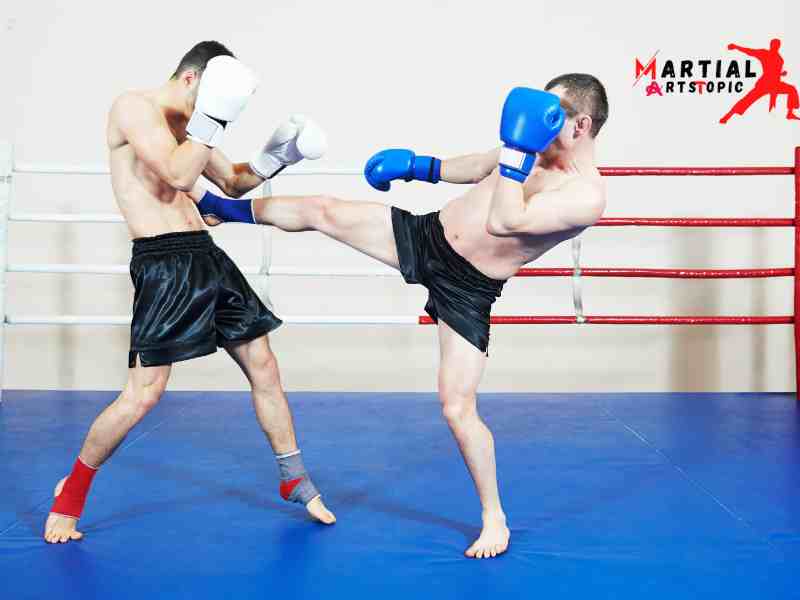
The training and techniques of combat sports, dedication and discipline are key. Whether you’re practicing boxing, MMA, or any other combat sport, consistent practice and focused training sessions are essential for honing your skills. From perfecting your footwork to mastering striking combinations, every aspect of combat sports requires attention to detail and a willingness to push yourself beyond your limits. By incorporating strength and conditioning exercises into your routine, you can improve your endurance and overall performance in the ring or octagon. Embracing the mental aspect of combat sports is equally important – staying focused, calm under pressure, and always seeking to learn and adapt will set you apart as a true contender in the world of combat sports.
Training Tips for Combat Sports
- Consistency is Key: The path to success in combat sports begins with consistent training. Make it a habit to dedicate regular time slots for practice and workouts, ensuring that you stay on track with your goals.
- Focus on Conditioning: Endurance and stamina are crucial in combat sports. Incorporate cardio workouts, strength training, and agility drills into your routine to build a solid foundation of physical fitness.
- Master the Basics: No matter how advanced you become, never underestimate the importance of mastering the fundamental techniques. Practice your footwork, stance, striking, and defensive moves diligently to establish a firm base for your skills.
- Spar Wisely: Engaging in sparring sessions is invaluable for improving your technique and adaptability. However, ensure that you spar with partners who prioritize safety and controlled intensity to avoid unnecessary injuries.
- Mental Preparation: Combat sports demand not only physical prowess but also mental fortitude. Develop mental resilience through visualization exercises, meditation, and positive self-talk to enhance your focus and concentration during competitions.
Combat Sports Techniques
- Striking Techniques: Whether it’s boxing, Muay Thai, or kickboxing, honing your striking techniques is essential. Work on perfecting punches, kicks, elbows, and knees with precision and power.
- Grappling Techniques: For martial arts such as Brazilian Jiu-Jitsu or wrestling, mastering grappling techniques like takedowns, submissions, and ground control is paramount for success in close-quarters combat.
- Defensive Maneuvers: Learning effective defensive strategies such as blocking, parrying, slipping punches, or evading takedowns can significantly reduce the risk of receiving damage during bouts.
- Footwork Mastery: Fluid footwork allows athletes to maneuver around opponents strategically while maintaining balance and stability. Practice agility drills to enhance your footwork skills and movement coordination.
- Strategy Development: Understanding how to strategize based on opponent analysis is an essential aspect of combat sports. Adapt your tactics based on the strengths and weaknesses of your adversaries to gain a competitive edge.
Benefits of Combat Sports
Combat sports offer a wide range of physical, mental, and emotional benefits for practitioners. Engaging in combat sports such as boxing, mixed martial arts (MMA), or judo can significantly improve cardiovascular health, endurance, strength, and overall fitness levels. In addition to the physical advantages, these activities also promote mental resilience, discipline, focus, and stress relief. Furthermore, combat sports provide an excellent opportunity for personal growth and self-defense skills. The holistic benefits of participating in combat sports make them an appealing choice for individuals looking to enhance their well-being and develop valuable life skills.
- Physical Fitness: Combat sports are an excellent way to stay fit and active. They provide a full-body workout that enhances cardiovascular health, agility, flexibility, and muscle strength. Regular training sessions help in toning the body and improving overall physical fitness.
- Self-Defense Skills: One of the most practical benefits of combat sports is learning self-defense techniques. By mastering these skills, individuals can feel more confident and secure in their ability to protect themselves if ever faced with a threatening situation.
- Stress Relief: Engaging in combat sports serves as a great stress-reliever. The intense physical activity releases endorphins, which are natural mood lifters, ultimately reducing stress levels and promoting mental well-being.
- Discipline and Focus: Training in combat sports demands discipline and focus. Practitioners learn to set goals, push through challenges, and maintain concentration during high-pressure situations both inside and outside of the training environment.
- Boosted Confidence: As you progress in your combat sports journey, you’ll notice a significant boost in self-confidence. Mastering new techniques, achieving fitness goals, and overcoming challenges all contribute to an increased sense of self-assurance.
- Weight Management: Combat sports provide an effective means for weight management and fat loss. The combination of intense workouts with proper nutrition helps individuals achieve their desired body composition goals.
- Community Engagement: Many combat sports are practiced within a supportive community setting where individuals encourage each other to grow and improve together. This fosters a sense of belonging and camaraderie among practitioners.
- Improved Coordination: The complex movements involved in combat sports help enhance coordination skills as practitioners learn to synchronize their body movements with precision.
- Mental Toughness: Enduring rigorous training sessions builds mental resilience as practitioners learn to push past their limits, handle pressure, and adapt to various challenges both on and off the mat or ring.
- Character Development: Combat sports emphasize values such as respect, humility, perseverance, and determination – qualities that extend beyond the training environment into everyday life.
FaQs:
What are the health benefits of practicing Combat Sports?
Engaging in combat sports offers a myriad of health perks that can significantly improve your overall well-being. From enhancing cardiovascular fitness and muscular strength to boosting endurance and flexibility, combat sports provide a full-body workout like no other. Additionally, these activities can contribute to weight management and bone density while promoting better sleep and reducing stress levels.
How can Combat Sports improve self-defense skills?
One of the most compelling reasons to explore combat sports is the invaluable self-defense skills they offer. By learning various techniques such as striking, grappling, and submission holds, individuals can gain confidence in their ability to protect themselves in real-life situations. Moreover, mastering these skills fosters a sense of empowerment and self-assurance.
Are there mental and emotional benefits associated with participating in Combat Sports?
The mental and emotional benefits of engaging in combat sports are truly remarkable. These activities not only enhance focus and concentration but also cultivate discipline, resilience, and determination. Furthermore, they provide an outlet for releasing pent-up emotions and stress while fostering a strong sense of community and camaraderie among practitioners.
Can Combat Sports help with weight loss and overall fitness?
Combat sports are undeniably effective for weight loss and overall fitness improvement. The high-intensity nature of these activities torches calories while building lean muscle mass. Additionally, the dynamic nature of combat sports ensures that workouts remain engaging and challenging, leading to enhanced physical conditioning.
What are the potential risks and safety considerations when engaging in Combat Sports?
While combat sports offer numerous benefits, it’s essential to acknowledge the potential risks involved. These may include injuries such as sprains, strains or even more severe trauma if proper precautions are not taken. However appropriate safety measures such as wearing protective gear during training sessions can significantly mitigate these risks.
How does participating in Combat Sports promote discipline and focus?
Participating in combat sports demands unwavering discipline and focus – qualities that extend beyond just physical training sessions into everyday life . Practitioners learn how to set goals , stay committed , work hard ,and overcome obstacles through sheer determination.
Are there any age restrictions for getting involved in Combat Sports?
Combat sports cater to individuals across all age groups . There are programs designed specifically for children , teenagers , adults ,and seniors alike . As long as one is physically capable ,there are opportunities available for everyone interested in pursing these activities .
What are some common misconceptions about Combat Sports and their benefits?
There are several misconceptions surrounding combat sports – one being that they promote violence or aggression . In reality ,they emphasize control ,respect,and humility ; values deeply ingrained within martial arts philosophies .
How can individuals get started with training in Combat Sports?
Getting started with training is easier than one may think! Individuals can begin by researching local gyms or dojos offering classes in disciplines such as karate,kickboxing,wrestling,Brazilian jiu-jitsu,and more . It’s important to find an experienced instructor who prioritizes safety while providing quality instruction .
What are some ways that practicing Combat Sports can positively impact one’s daily life?
Practicing combat sports instills valuable life lessons such as perseverance,respect,self-discipline,and humility . These attributes inevitably spill over into various aspects of daily life including work,school,family relationships,and personal endeavors .
Conclusion
Combat sports offer a unique combination of physical fitness, mental discipline, and strategic thinking. Whether you’re drawn to the striking techniques of boxing and Muay Thai or the grappling skills of Brazilian Jiu-Jitsu and wrestling, there’s something for everyone in the world of combat sports. As you continue your journey in this exciting realm, remember to always prioritize safety, respect for your opponents, and continuous improvement. Embrace the challenges, celebrate the victories, and stay committed to honing your skills both inside and outside the ring or octagon. Remember that while it’s okay to be competitive, the true essence of combat sports lies in personal growth and self-mastery.
